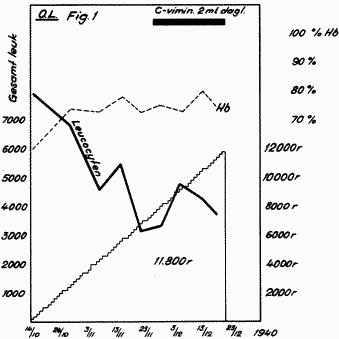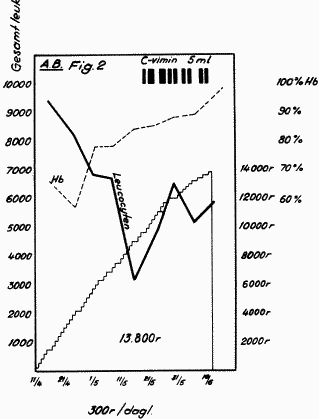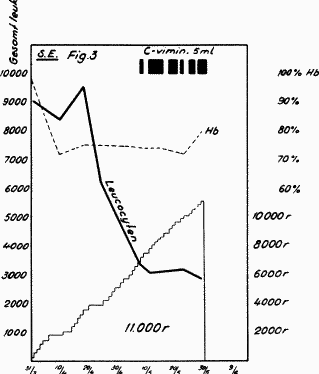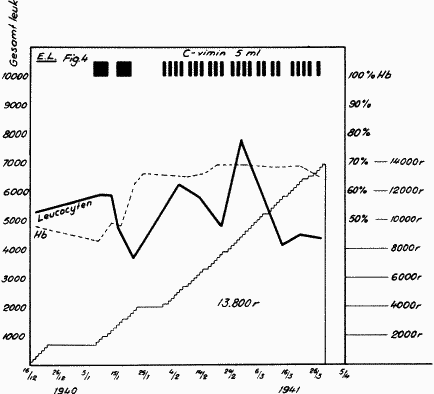FROM THE RADIATION DEPARTMENT OF THE CENTRAL HOSPITAL AT VÄSTERÅS
(CHIEF: AXEL RENANDER, M.D.)
THE TREATMENT OF X-RAY LEUKOPENIA WITH
VITAMIN C1
by
Arne Clausen.
1(Received by the ed. on 4. VIII. 1941)
At the local x-ray [treatment] department attempts have taken place for several years
in the radiation treatment of inoperable tumors of the fornix- and corpus ventriculi,
following a technique devised by Dr. Renander. As a rule, with somewhat declining
patients it usually proved difficult now and then to carry out the the planned treatment,
at least without interruption, since in the course of treatment a rather pronounced
leukopenia occurred, despite satisfactory initial values of the number of white corpuscles
and that the hemoglobin content and red corpuscle count had nevertheless indicated a halt
of the increase in tendency for occult bleeding.
In these patients, with their gastrointestinal disturbances and achylia, one has cause
to expect hypovitaminosis C, since vitamin C in these situations is probably
destroyed to a large extent before it could be absorbed.
It occurred to me to attempt to increase the resistance-strength of these patients
through parenteral administration of vitamin C. A further suggestion was from individual
observation of one of the leukemia patients, with whom each administration of vitamin C,
taken together with the prescribed Aneurin, prompted a significant, though temporary,
increase in the number of white blood corpuscles.
So far only 10 patients have received this supportive vitamin C treatment; however the
results were so encouraging that a short provisional participatory [study] might be
authorized.
To economise, in no instance did we supply vitamin C at the beginning of radiation
treatment, but rather only when such a marked leukopenia occurred that interrupting the
treatment became necessary. The patients then received usually 5 ml vitamin C*
intravenously (= 0.5 g or 10 000 I.E. ascorbic acid), initially daily, later every
second day. In mild cases, they received vitamin C only every second or third day. To
ensure that the supplied vitamin C was really absorbed, intravenous administration was
selected. X-ray irradiation was carried out as planned.
Under these conditions it is scarcely to be expected that a real increase in the white
blood corpuscle count takes place; nevertheless this occurred in a few cases. In other
cases the rapid depression of the leukocyte count was halted, and either held at the same
level with moderate variation, or the depression was insignificant; the scheduled
irradiation could in all cases be carried out.
Indeed, one can never foresee which patients will develop radiation leukopenia to such
a degree as to jeopardise further treatment. Therefore the objection will probably be
raised that our patients would perhaps do as well without vitamin C treatment, which I do
not believe. In all cases we would have been compelled, in accordance with our experience
acquired without vitamin C treatment, to take a shorter or longer break in the radiation
treatment; whereas we could now carry it out continuously.
On what the effect is based, I do not know; also no attempts were made to determine the
vitamin C equilibrium of these patients. Should our experience be confirmed, then we
should hope that a colleague experienced in vitamin research will investigate the
theoretical basis.
Recently Cramer and Brodersen (Münch. Med. Wochenschr., v. 88: 619, 1941) treated
leukopenia in connection with X-ray irradiation with follicle hormone in doses of
50 000 E Progynon in accordance with their specification, with good effect. We
checked this preparation in two cases, but found it ineffective.
In conclusion are some cases presented graphically (Fig. #4). [Figures unavailable with
this version]
ZUSAMMENFASSUNG
Es ist Verf. bei zehn Patienten gelungen, einer bei langwieriger Röntgenbehandlung von
Ventrikelkarzinom auftretenden, ausgesprochenen Röntgenleukopenie durch intravenöse
grosse C-Vitamin-Dosen Einhalt zu tun.
SUMMARY
The writer succeeded in ten cases in checking a pronounced x-ray leukopenia, which had
appeared in connection with protracted x-ray treatment of cancer of the stomach, by means
of large intravenous doses of vitamin C.
RÉSUMÉ
Chez dix malades 1’auteur a réussi à arrêter par de grosses
doses intra-veineuses de Vitamine C une leucopénie accentuée, due aux rayons roentgen,
qui s’était manifestée au cours du traitement radiothérapique prolongé de cancers
de l’estomac.
Markings in the figures. |
Stepped Line = X-ray dosage; labels on right.
Solid Line = Leukocyte count; labels on left.
Dashed Line =Hemoglobin count; labels on right.
Black Rectangle =Vitamin C* injections
Data on the abscissa. |
 |
Figure 1. 67 year old man in rather good overall condition, the x-ray examination
showed a hen’s egg- sized, coarsely-studded tumor approximately around the cardia and
beneath. Treatment was with 200 r daily (Thoraeus filter; 50 cm FHD). After a total dose
of 6 400 r the leukocyte count had dropped from 7 900 at the start of treatment
to 3 100. The patient then received 2 ml Vitamin C* daily. At the end of treatment
the leukocyte count was 3 800 after a total dose of 11 800 r. |
Figure 1
|
|
 |
Figure 2. 65 year old woman, who had received an ad modum Billroth II gastrectomy. In
the distal part of the remaining stomach a wall infiltration had spread. The patient
received treatment with 300 r daily (Thoraeus filter; 50 cm FHD). After a total dose of
6 400 r the leukocyte count had dropped from 9 400 to 3 200. The patient
the received every second day 5 ml Vitamin C*. With a total dose of 13 800 r, upon
the final treatment the leukocyte count was 5 800. |
Figure 2
|
|
 |
Figure 3. 49 year old woman with a half year-old stomach anamnesis and a large /body/
carcinoma. Treatment with 300 r daily (Thoraeus filter; 50 cm FHD). After a total dose of
6 800 r the leukocyte count had dropped from 9 000 to 3 100. The patient
received thereafter 5 ml Vitamin C*, mainly daily. The leukocyte depression was halted and
remained at approximately 3 000 till the end of treatment. |
Figure 3
|
|
 |
Figure 4. 50 year old woman with a large fornix carcinoma of the stomach and moderate
trouble in swallowing. Patient received treatment with 200 r daily (Thoraeus filter; 50 cm
PHD). Practically from the beginning, this patient received large doses of Vitamin C*, and
the leukocyte level was satisfactory throughout the entire period. From beginning to end
of treatment, a total of 11 800 r administered, the white corpuscles [were at]
4 400 per mm3. Three months thereafter the leukocyte count was
11 300. |
Figure 4
|
|

From Acta Radiologica, February 28, 1942, Volume 23, Binding 1, Number
131, pp. 95-98
Translator’s notes:
- Röntgen (roentgen) has been replaced with the more familiar term “x-ray”;
“leuko-” of the German has been retained.
- The term “C-Vimin forte” was repeatedly used in the original text; this was
probably a trademarked brand name of the era. The La Roche Company was known at the
time to use the trademark Redox Forte.
For reduced confusion but to identify each occurrence, “C-Vimin forte” has been
replaced with “vitamin C*”.
- The occasional unknown or difficult term is enclosed in / slashes /, and additional
[bracketed] terms have been added to aid comprehension.
HTML Revised
05 July, 2004.
Formatting © 1999 AscorbateWeb
Translation © 1999 by Alexander Stoll



